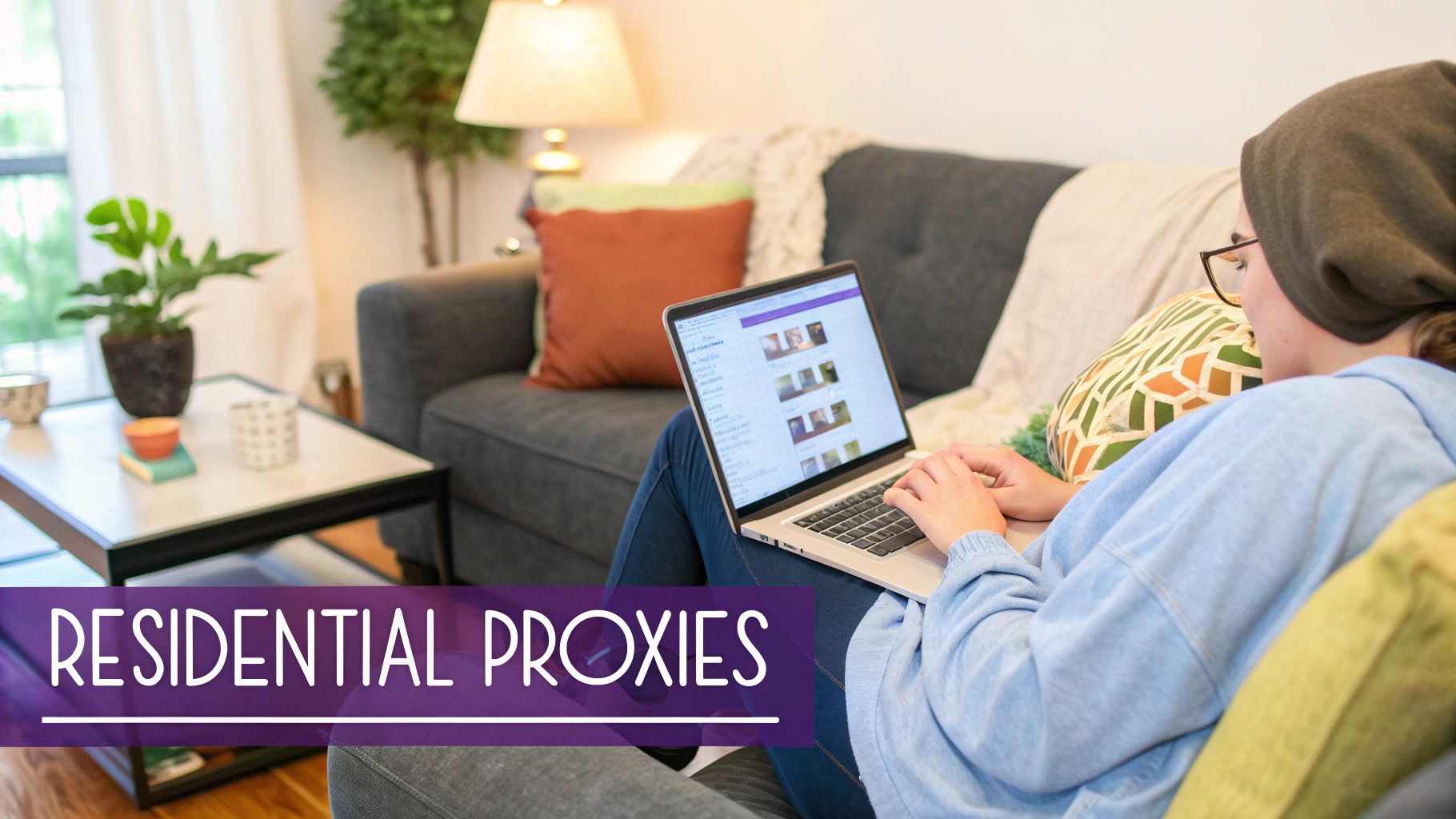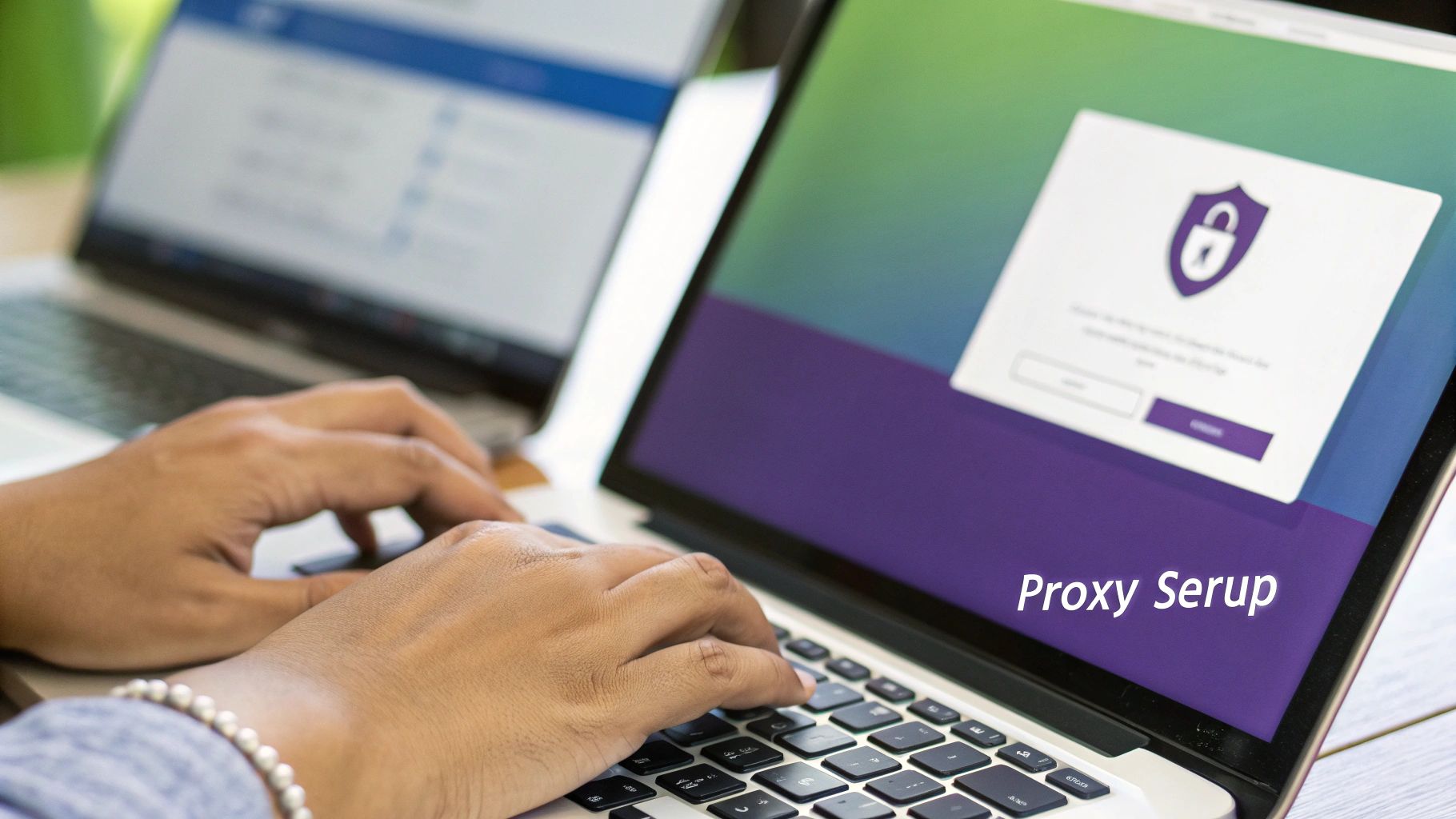If you're managing multiple Instagram accounts or using any kind of automation, you've probably run into blocks or warnings. That's where residential proxies for Instagram come in. Think of them as a way to give your online activity a legitimate, human identity by routing your connection through a real home internet address. This makes everything you do look completely natural to Instagram’s watchful eye.
Understanding Residential Proxies for Instagram

Every action you take on Instagram leaves a digital footprint: your IP address. This unique string of numbers tells Instagram exactly where you are. So, if you’re running five client accounts from the same office IP, Instagram sees all that activity coming from one commercial spot. That pattern screams "bot" and is a massive red flag.
This is where a proxy becomes your best friend. A proxy is just a middleman that sits between your computer and Instagram’s servers. Instead of your connection going directly to Instagram, it’s routed through the proxy first, borrowing its IP address along the way. But for a platform as tough as Instagram, the type of proxy you use makes all the difference.
The Problem with Datacenter Proxies
The most common and cheapest option you'll find are datacenter proxies. As the name suggests, their IPs come from huge commercial data centers owned by cloud companies. They're fast, but they're also incredibly easy for Instagram to spot. After all, a real person isn’t scrolling through their feed from an Amazon Web Services server.
Actionable Insight: If you've ever tried to log into an Instagram account and received an immediate "Suspicious Login Attempt" warning before you could even do anything, there's a high chance you were using a datacenter proxy. Instagram's systems are built to block these IPs on sight.
Instagram’s systems are designed to block these IPs on sight, sometimes before you can even log in. This makes them pretty much useless for any serious account management.
Why Residential IPs Are the Gold Standard
This leads us to the real solution: residential proxies for Instagram. These proxies use IP addresses assigned by Internet Service Providers (ISPs) to actual homes. When you connect through a residential proxy, your activity looks like it’s coming from a regular person’s home Wi-Fi network somewhere in the world.
This legitimacy is their superpower. To Instagram, a request from a residential IP is completely natural and trustworthy. It's the ultimate camouflage, letting you manage multiple accounts or run automation tools without raising suspicion.
This distinction is so important that the global market for Instagram proxies, dominated by residential types, was estimated to hit $280 million in 2025. In fact, 48% of businesses on the platform now use them to scale their operations safely. You can explore more data on how businesses use proxies for Instagram to see just how critical they've become.
To make it even clearer, let's compare the most common proxy types and how Instagram sees them.
Comparing Proxy Types for Instagram Use
This quick table breaks down how different proxies stack up. You'll see why residential proxies consistently come out on top for any serious Instagram-related work.
| Proxy Type | IP Source | Instagram's Perspective | Best Use Case | Risk Level |
|---|---|---|---|---|
| Datacenter Proxy | Cloud data centers | Obvious commercial IP, immediately suspicious. | General web browsing (not for social media). | Very High |
| Residential Proxy | Real home ISP addresses | Looks like a genuine, everyday user. | Multi-account management, automation, scraping. | Very Low |
| Mobile Proxy | Mobile carrier networks (4G/5G) | Looks like a real user on their phone. | The most "human" activity, ideal for mobile-first apps. | Very Low |
While mobile proxies are also fantastic, they tend to be more expensive. For most users, residential proxies hit the sweet spot of high trust and reasonable cost.
Ultimately, choosing a residential proxy is all about blending in. It allows your management activities to become indistinguishable from the millions of genuine users on the platform every day, giving you a safe and stable foundation for growth.
Gaining a Strategic Edge with Instagram Proxies

Knowing what a residential proxy is is one thing. But the real magic happens when you use them to get a serious upper hand on Instagram. For social media agencies and serious marketers, this is where you unlock true scale and stop wasting time.
Think about an agency juggling 20 different client accounts. Without proxies, that's a logistical nightmare—you'd need a stack of phones and different Wi-Fi networks just to avoid getting everything flagged. With residential proxies for Instagram, you can run all 20 accounts from a single laptop. Each account gets its own legitimate IP, so to Instagram, it just looks like 20 different people logging in from their homes.
Mastering Multi-Account Management
The biggest win here is running a bunch of accounts without Instagram's algorithm getting suspicious. When the platform sees multiple logins from the same IP address, it immediately thinks "spam" or "bot farm." That's a fast track to action blocks or, even worse, permanent bans.
Practical Example: A digital marketing agency in Chicago uses a pool of residential proxies to manage 30 client accounts. Each account is assigned a dedicated proxy from a location relevant to the client's audience—a New York-based brand gets a New York IP, while a London-based one gets a UK IP. This simple strategy has reduced account-related flags by over 90% and allows their team to work efficiently from one central dashboard.
This separation is your safety net. If one account gets flagged for some reason, the rest are completely safe because they're on totally different IPs. It's like having digital firewalls between each client. This is non-negotiable for serious account managers. Our guide on using proxies for social media dives deeper into this for other platforms, too.
Enabling Safe and Effective Automation
Automation can be a massive growth engine, but it's also the quickest way to get your account shut down if you're careless. Residential proxies are the key to making automation safer by spreading out your actions across tons of clean, trusted IPs.
Let's say you're automating engagement to connect with a target audience. A rotating residential proxy makes hundreds of actions look like they're coming from hundreds of different, real people.
Here’s a practical example of how it works:
- Action 1 (Like post #1): Your request is routed through a residential IP in Dallas.
- Action 2 (Comment on post #2): Your request is routed through a different residential IP in Miami.
- Action 3 (Follow a new user): Your request is routed through yet another residential IP in Seattle.
This rotation makes your automation footprint almost impossible for Instagram to trace back to a single source. Of course, to make this all worthwhile, you need to know how to boost your Instagram engagement rate with interactions that actually add value.
Unlocking Global Market Research
Beyond just managing accounts, proxies are a game-changer for market research and spying on the competition. They let you see Instagram exactly as a local user would anywhere in the world.
Practical Example: An e-commerce brand wants to launch a new sneaker line in Germany. By using a residential proxy located in Berlin, their team in Los Angeles can search for relevant hashtags like #sneakerheadgermany and see the exact same search results, trending posts, and local ads that a potential customer in Berlin would see. This provides invaluable, unfiltered insight into the local market.
It turns a simple tech tool into a powerful engine for building a scalable, global Instagram presence.
How to Choose a High-Quality Proxy Provider

Picking the right provider for residential proxies for Instagram is a big deal. It's not just about buying a service; you're finding a partner to keep your accounts safe. With so many options out there, it’s easy to feel lost. The trick is to ignore the flashy ads and dig into the technical stuff that actually protects your accounts and keeps things running smoothly.
Your provider’s quality is your first line of defense. Go with a cheap, low-quality service, and you'll end up with overworked, flagged IPs. That’s just as bad as using no proxy at all. Let's walk through what you really need to look for.
The Power of a Massive and Diverse IP Pool
This is the single most important factor. Think of it like a deck of cards. A small provider is like playing with a deck where half the cards are marked—it’s only a matter of time before you draw one that gets you caught.
A top-tier provider will have millions of ethically sourced IPs scattered all over the globe. This massive pool ensures you always get a clean, unique address that hasn't been recently used or flagged by Instagram. The bigger the pool, the lower your chances of ever using a "burnt" IP.
Actionable Insight: Before buying, ask the provider two questions: "How large is your IP pool?" and "How often do you refresh it?" A good answer is "millions of IPs" and "daily." A bad sign is a vague answer or a number in the thousands. This diligence protects your investment.
Rotating vs. Static Residential Proxies
Next up, you need to get the difference between the two main types of residential proxies. They're both useful, but for very different reasons.
-
Static Residential Proxies: These give you a single, dedicated residential IP address that never changes. This is the gold standard for managing a specific Instagram account. Why? Because it builds a consistent, trustworthy history, making your activity look just like a real person logging in from their home computer every day.
-
Rotating Residential Proxies: These proxies automatically swap your IP address with every request or after a set time. They're perfect for large-scale data gathering or high-volume automation where you don't need to maintain a consistent identity.
For day-to-day account management, a static IP is almost always your best and safest bet. If you're scraping public hashtag data, rotating proxies are far more efficient.
Performance Metrics That Truly Matter
Don't let the technical jargon confuse you. When it comes to performance, only two numbers really matter: success rate and connection speed. These determine if your automation tools can even do their job.
A provider’s success rate tells you what percentage of your connection requests will go through without failing. For reliable Instagram automation, you need a rate of 99.5% or higher. Anything less means your tools will constantly hit roadblocks, actions will get missed, and your whole operation will grind to a halt.
Recent benchmarks show the median global success rate for residential proxies is a solid 99.56%, but the best providers hit 99.87% in competitive regions like the United States, where Instagram's detection is at its peak. Every fraction of a percent counts.
Your Provider Evaluation Checklist
When you start comparing providers, it's easy to get lost in the marketing noise. This checklist will help you focus on the features that actually matter for keeping your Instagram accounts safe and sound.
| Feature | Why It Matters for Instagram | What to Look For (Good vs. Bad) |
|---|---|---|
| Ethical IP Sourcing | Ensures your IPs come from real, consenting users, which keeps them off blacklists. | Good: Clear, transparent policies on how IPs are sourced. Bad: Vague or no info on where IPs come from. |
| Geo-Targeting Options | Lets you match your proxy's location to your account's target audience for more authentic activity. | Good: City and state-level targeting options. Bad: Only country-level targeting. |
| Usability & Integration | A simple dashboard and clear instructions mean you spend less time on setup and more time working. | Good: An easy-to-use interface with helpful guides. Bad: Complicated setup with poor documentation. |
| Pricing Structure | Clear pricing helps you manage costs without getting hit by surprise fees. | Good: Transparent pay-per-GB or plan-based pricing. Bad: Confusing credit systems or hidden charges. |
Choosing a provider like IPFLY, which gives you detailed network insights and flexible plans, can make this whole process much easier. You can see the different options by checking out their residential proxy pricing.
Ultimately, putting your money into a high-quality provider isn't an expense—it's an investment in the security and longevity of your Instagram operations.
Setting Up Your Proxies for Instagram Automation

Alright, you’ve picked out a quality provider and you're ready to put your residential proxies for Instagram to work. The good news? This is way simpler than it sounds. You don’t need to be a network wizard—just a bit of copy and paste.
The best way to do this is to plug your proxy details directly into your Instagram automation tool or a multi-account browser. This keeps the proxy connection isolated to just that software, so the rest of your computer’s internet traffic stays on your regular connection.
Think of it as giving that specific app its own private tunnel to the internet. This ensures only your automated Instagram activity uses that clean, residential IP address.
Integrating Proxies into Your Tools
When you buy a residential proxy, your provider will give you a set of credentials, usually in a standard format that nearly all tools and browsers understand. It's really just a matter of finding the right settings menu.
You’ll typically need these four pieces of info for each proxy:
- Host/IP Address: The proxy's server address (e.g.,
en.ipfly.net). - Port: The specific port number for the connection (e.g.,
7777). - Username: Your login username.
- Password: Your login password.
Most professional automation dashboards have a dedicated spot for proxy management. You'll find a button like "Add Proxy" or "Configure Proxy" that opens a simple form. If you want to see how this looks on different platforms, you can find detailed guides on integrating proxies with different software.
Practical Example: Let's say you're using an automation tool or a multi-profile browser like GoLogin. You'd go into the settings for a specific Instagram account and look for a "Proxy" or "Network" tab. From there, you just copy the host, port, username, and password from your IPFLY dashboard into the matching fields and hit save. Done. The tool will now route all of that profile's activity through your new residential IP.
The Golden Rule: One Proxy Per Account
This is the single most important rule to follow: assign one unique, static residential proxy to each Instagram account. Never, ever share one proxy across multiple accounts.
When you do that, you're creating a direct digital footprint linking those accounts together. If one gets flagged, Instagram can easily trace that IP and bring the hammer down on every other account using it. This one-to-one mapping is your biggest safety net, making each account look like a separate, real person using their home Wi-Fi.
Warming Up Your New Proxy-Account Pair
Finally, don't just flip the switch and go full-throttle with automation. You need to "warm up" the new proxy and account pairing to build trust with Instagram's algorithm. A sudden flood of activity from a brand-new IP address is a huge red flag.
Follow this simple, actionable warm-up routine for the first 3-5 days:
- Days 1-2: Stick to light, manual actions. Just log in, scroll the feed, watch some stories, and maybe like 5-10 posts per day. The goal is to establish the new IP as the account's primary location.
- Days 3-4: Slowly introduce automation with very low limits. Think 10-20 follows and 20-30 likes, spread out across the day.
- Day 5 and beyond: You can start gradually increasing your automation limits to your target levels, but always keep them within reasonable, human-like numbers.
This gradual ramp-up builds a natural activity history, signaling to Instagram that the new IP associated with your account is legit. It’s a simple step that turns a potentially risky setup into a stable foundation for your long-term automation strategy.
Essential Best Practices for Safe Proxy Use
Just grabbing a set of high-quality residential proxies for Instagram isn't a magic fix for keeping your accounts safe. The real secret is in how you use them. Your number one goal should be making every automated action look completely human, blending right in with the millions of other people on the platform.
Think of your proxy like a flawless disguise; it gets you into the party without anyone looking twice. But once you're inside, it's your behavior that decides whether you get to stay. If you start running around shouting and making a scene, you'll be kicked out, no matter how good the disguise is. The same logic applies here. Your entire strategy has to revolve around mimicking natural, human-like activity.
The Golden Rule: One Account, One Proxy
The most important best practice is dedicating one static residential proxy to each Instagram account. This creates a consistent and believable digital history. When an account always logs in from the same residential IP, it just looks like a real person using their home internet, day in and day out.
This one-to-one relationship is non-negotiable if you're serious about the long-term health of your accounts. It keeps each account isolated, so if one gets flagged for some reason, the others are completely insulated. Sharing an IP across multiple accounts creates an obvious footprint that can trigger chain reactions and mass suspensions.
The demand for this level of security has caused the market to boom. Between 2023 and 2025, the residential proxy market has seen massive growth, with the global proxy market valued at $4.29 billion in 2023 and expected to reach $7.59 billion by 2032. Static residential proxies, which give you a fixed household IP, are now essential for safely scaling Instagram operations. You can discover more insights about the growth of static residential proxies and why they matter so much to marketers.
Master Your Session Management
To make things look even more natural, you need to handle your proxy sessions the right way. A "sticky session" is a feature that lets you keep the same residential IP for a set amount of time, from a few minutes to several hours.
This is way more realistic than rotating your IP with every single action. After all, a real person's home Wi-Fi address doesn't change every 30 seconds.
Actionable Tip: Set your sticky sessions to last somewhere between 30 minutes and a couple of hours. This length perfectly mimics a typical user's browsing session—they log on, scroll for a while, and then log off, all from the same IP address.
Align Your Proxy with Your Audience
Here's another simple but powerful tactic: geo-targeting. Match your proxy's location to where the account's target audience is. If you're managing an account for a coffee shop in London, using a proxy with a UK IP address makes all your activity look authentic and relevant.
This alignment reinforces the legitimacy of the account's interactions. It signals to Instagram that your engagement is geographically logical, which is a subtle but important trust factor the platform's algorithms definitely notice.
Implement Safe Automation Settings
Finally, your automation settings are where you really fine-tune your human-like behavior. Aggressive, robotic settings are the fastest way to get flagged, even with a perfect proxy. You need to focus on moderation and randomization.
Here are a few concrete examples of safe settings you can apply right away:
- Set Realistic Action Limits: Keep your daily actions within believable human limits. A good starting point is 50-100 follows/unfollows and 100-150 likes per day, spread out over many hours. Never try to max out the theoretical limits.
- Use Randomized Delays: A bot might perform an action every 30 seconds like clockwork. A human never would. Configure your automation tool to use random delays between actions—for instance, waiting anywhere from 45 to 90 seconds between likes or comments.
- Simulate "Off" Hours: No real person is active on Instagram 24/7. Schedule your automation to run during realistic hours, with built-in breaks for "sleep" and "work." A typical schedule might be active for 8-10 hours a day with natural pauses in between.
By combining a top-tier residential proxy with these smart operational practices, you build a robust and sustainable strategy. This approach turns automation from a potential liability into a safe, effective tool for steady Instagram growth.
Common Questions About Instagram Residential Proxies
Diving into the world of proxies can feel a bit technical at first, but it doesn't have to be. Let's clear up some of the most common questions people have. Here are some straight answers to help you use residential proxies for Instagram with total confidence.
Can Instagram Detect a Residential Proxy?
Short answer: No, not really. A top-tier residential proxy uses an IP address that looks exactly like a real person’s home internet connection. To Instagram, it's completely indistinguishable from any other user.
But here’s the catch: Instagram is an absolute master at spotting unnatural behavior. Your real protection comes from pairing a legitimate residential IP with smart, human-like automation. If your bot suddenly likes 500 posts in an hour, Instagram will flag the strange activity, not the proxy itself.
Should I Use Rotating or Static Proxies?
This one comes down to what you’re trying to do. Each type is built for a different kind of Instagram task.
- Static (or Sticky) Proxies: Think of these as your go-to for managing specific Instagram accounts. Using the same IP address for every login builds a consistent history, which signals trust and stability to Instagram's algorithm.
- Rotating Proxies: These are the workhorses for large-scale data gathering. If you're scraping thousands of public profiles or hashtag feeds, the constant IP rotation keeps you from hitting rate limits tied to a single address.
Actionable Insight: For managing an account, consistency is key—use a static proxy. For scraping data, you need volume and speed—go with a rotating proxy.
How Many Instagram Accounts per Proxy?
The answer here is simple and non-negotiable: one account, one proxy. This is the golden rule for safely managing multiple accounts.
When you link several accounts to a single IP, you're creating an obvious digital footprint. If just one of those accounts gets flagged for any reason, Instagram can easily trace that IP and penalize every single account connected to it. It’s the fastest way to get your entire network shut down.
Are Residential Proxies Legal to Use?
Absolutely. Using residential proxies is perfectly legal. The technology itself is just a neutral tool designed for privacy and better access online.
The important part is how you use them. While the proxy itself is fine, aggressive automation or scraping private data can violate Instagram's Terms of Service. Always focus on ethical management and playing by the platform’s rules to keep your operations safe and above board.
Ready to manage your Instagram accounts with the security and reliability of premium residential IPs? IPFLY offers access to over 90 million ethically sourced addresses, ensuring your operations stay safe and effective. Get started with IPFLY's residential proxies today!


